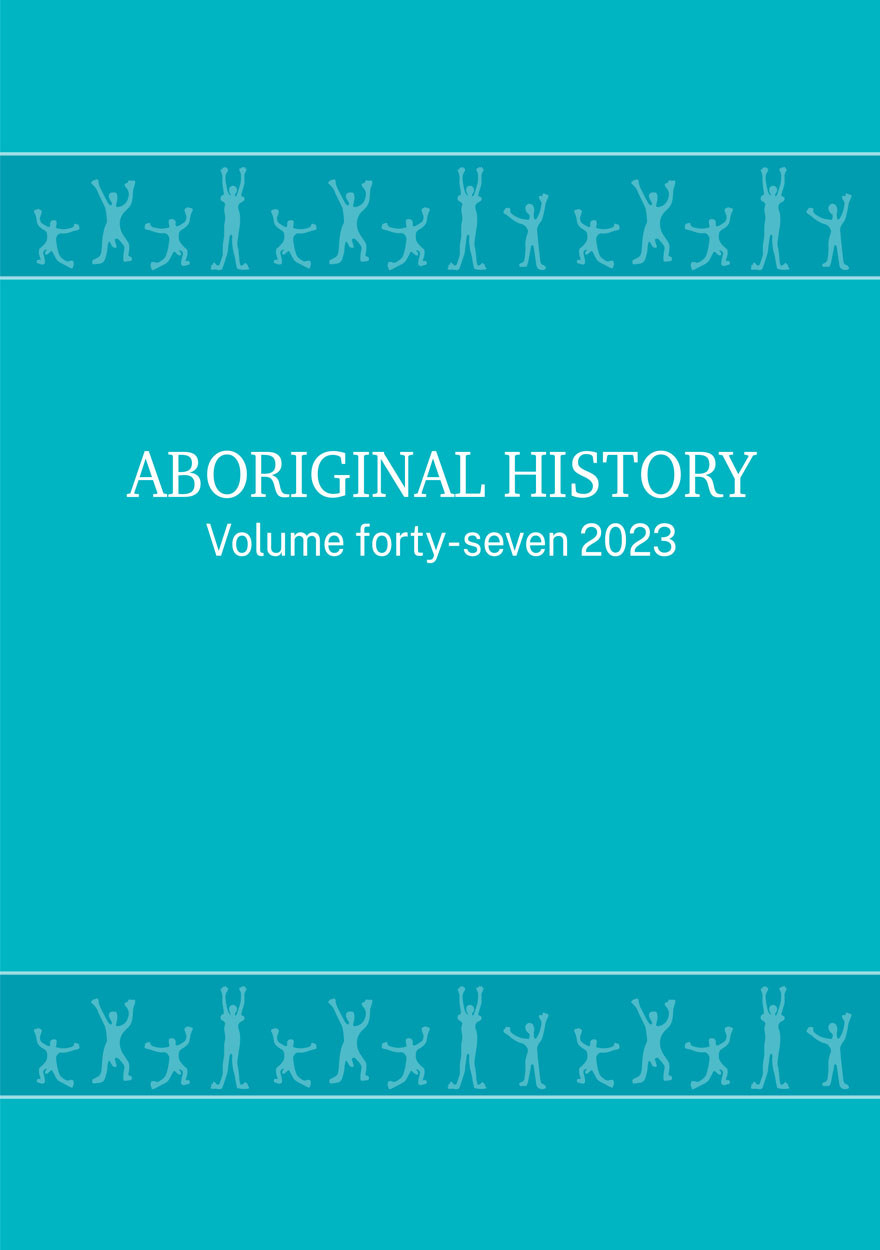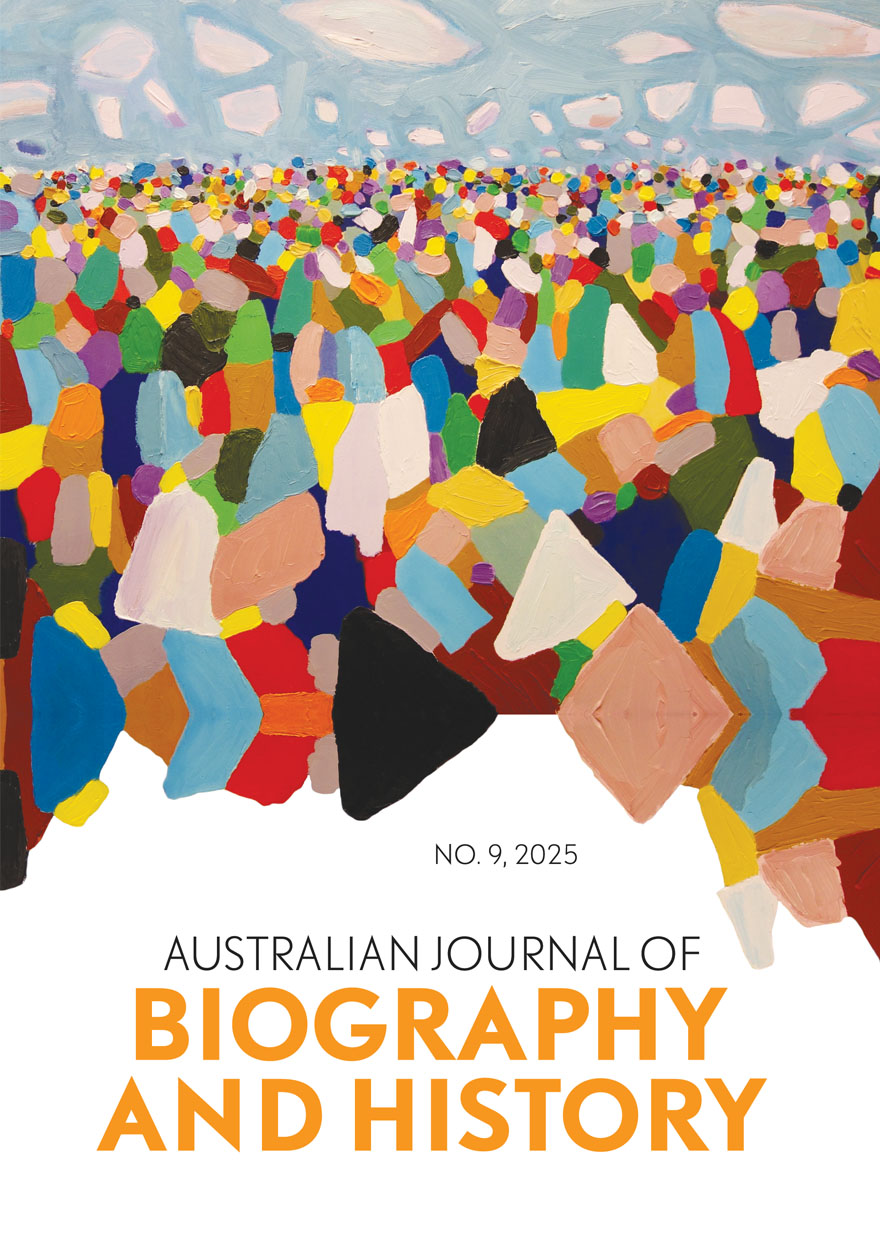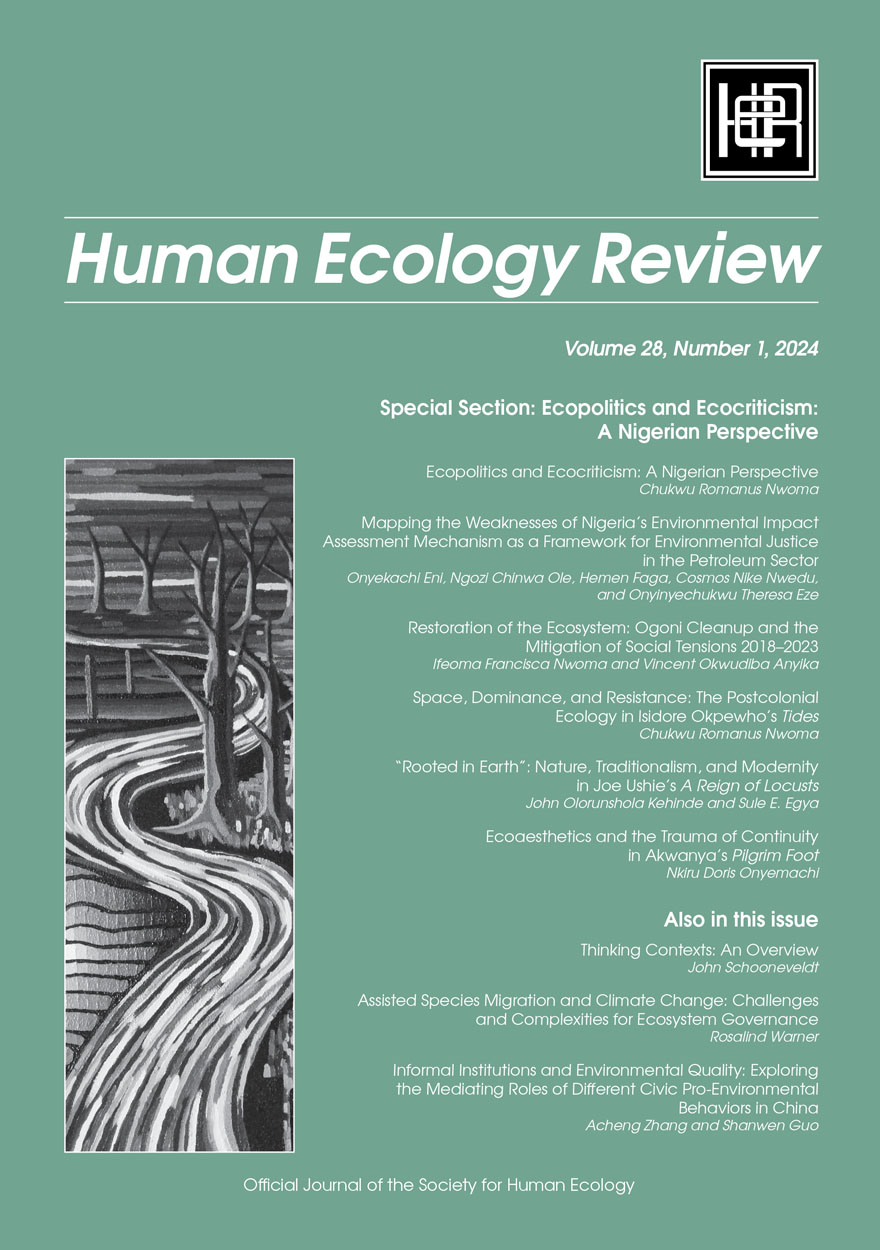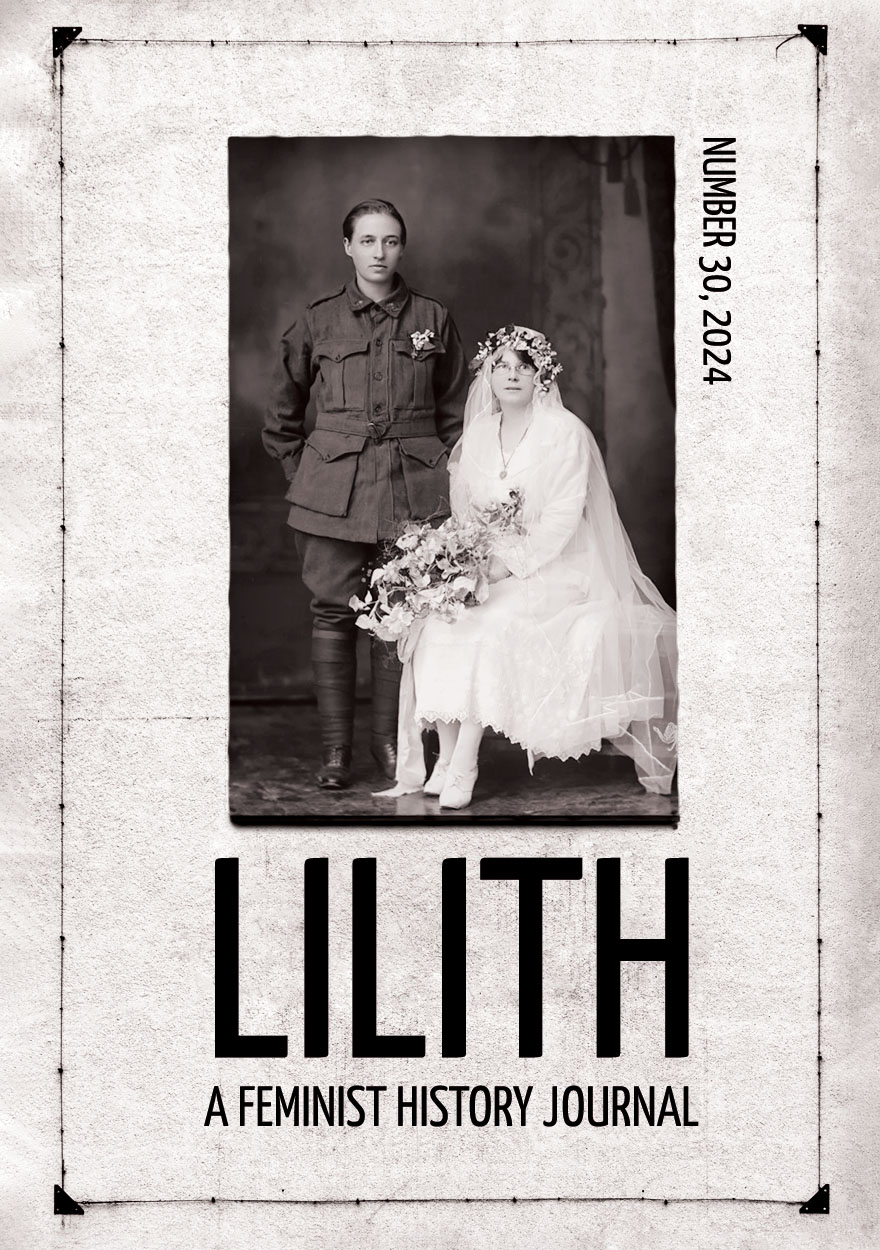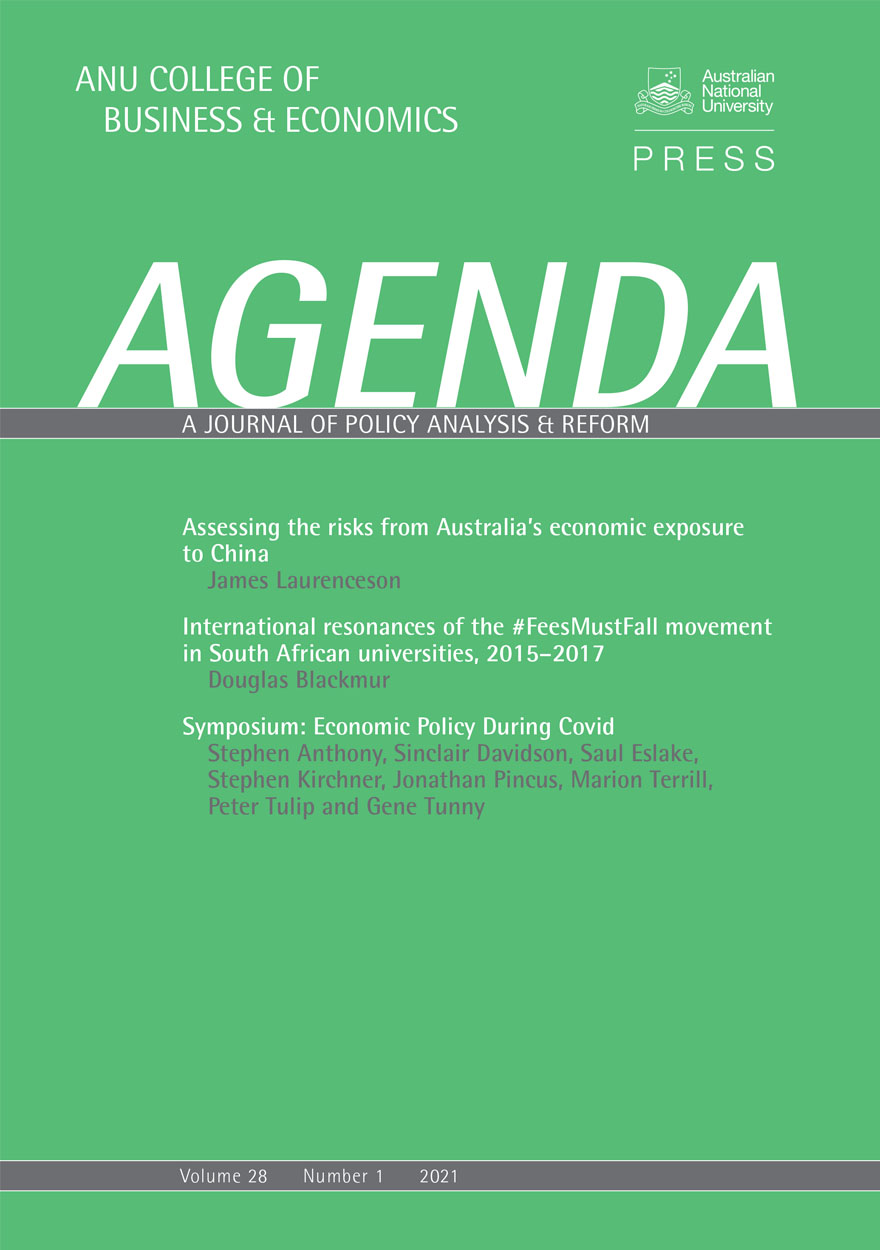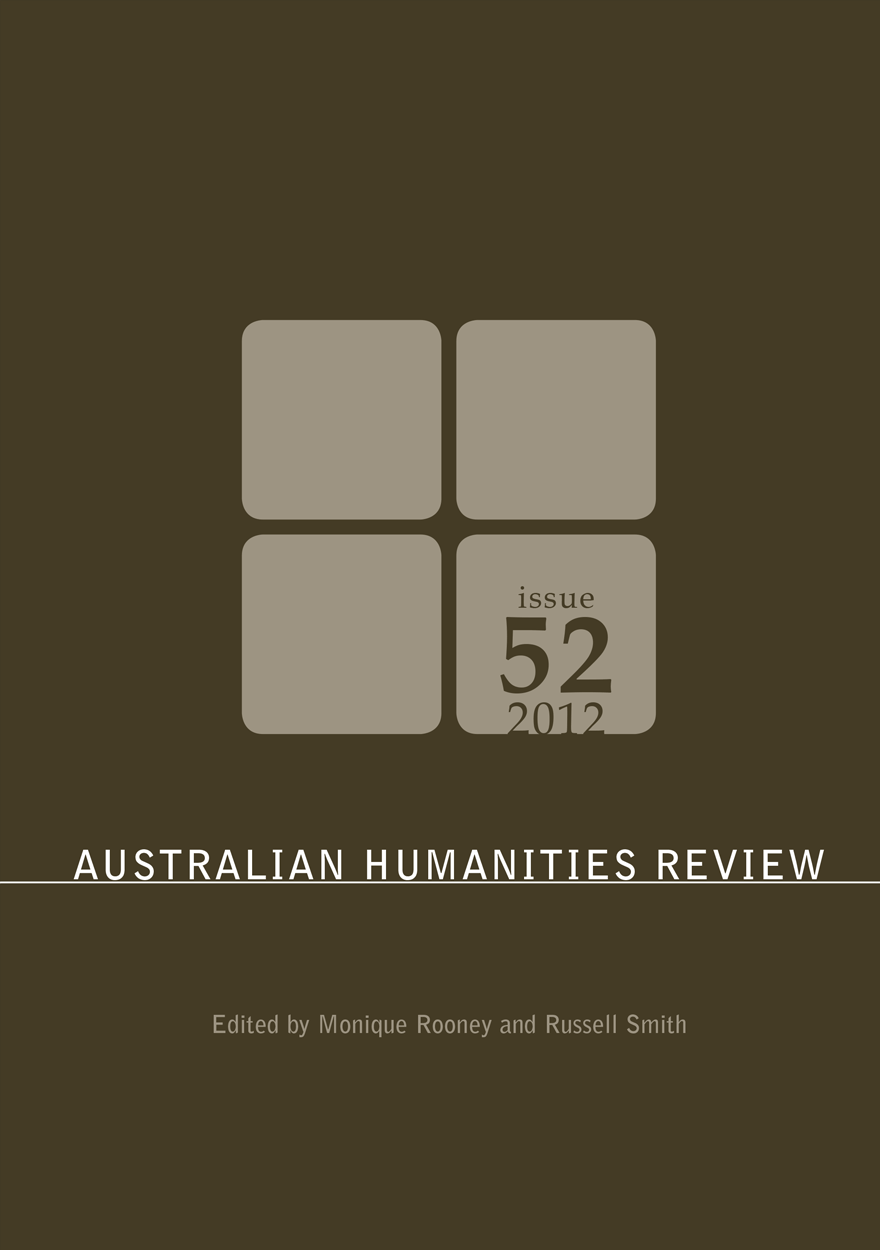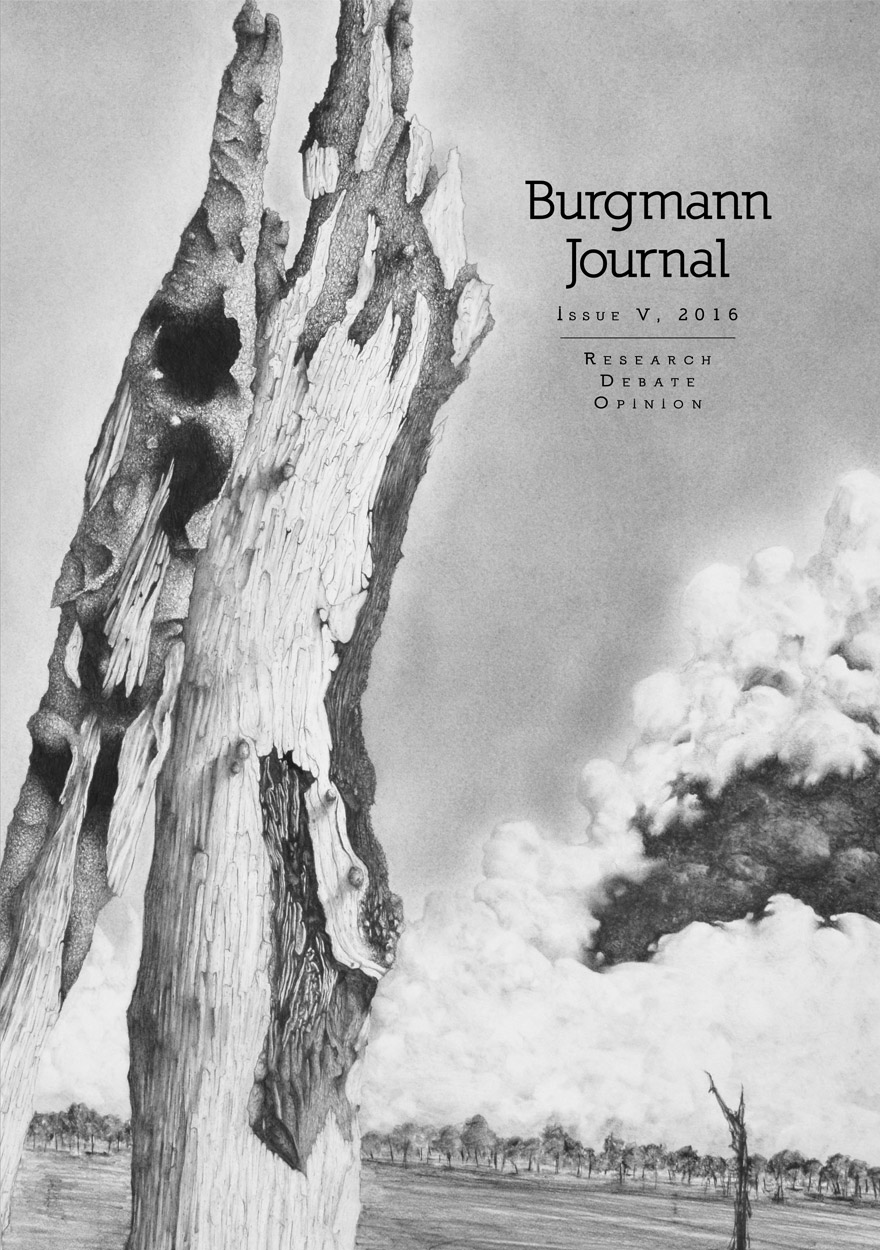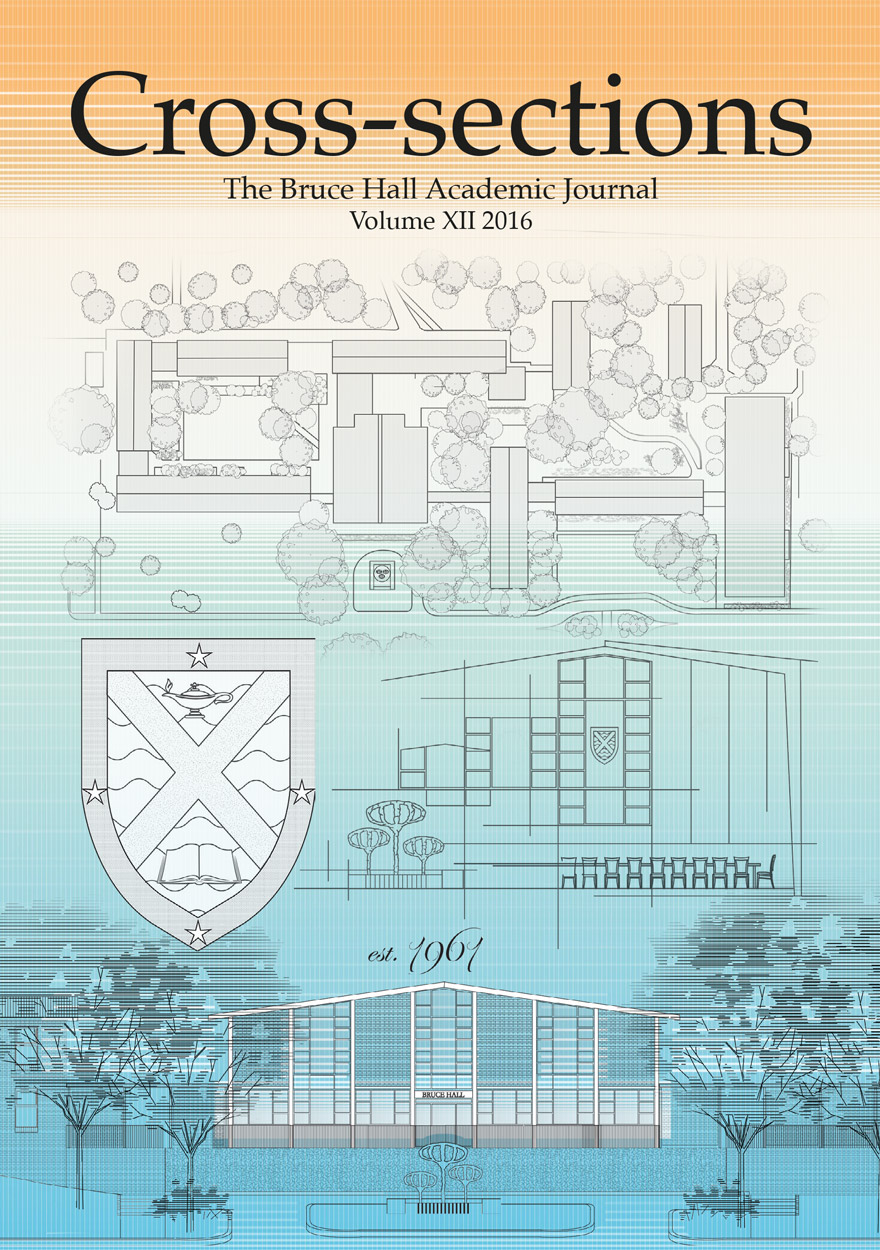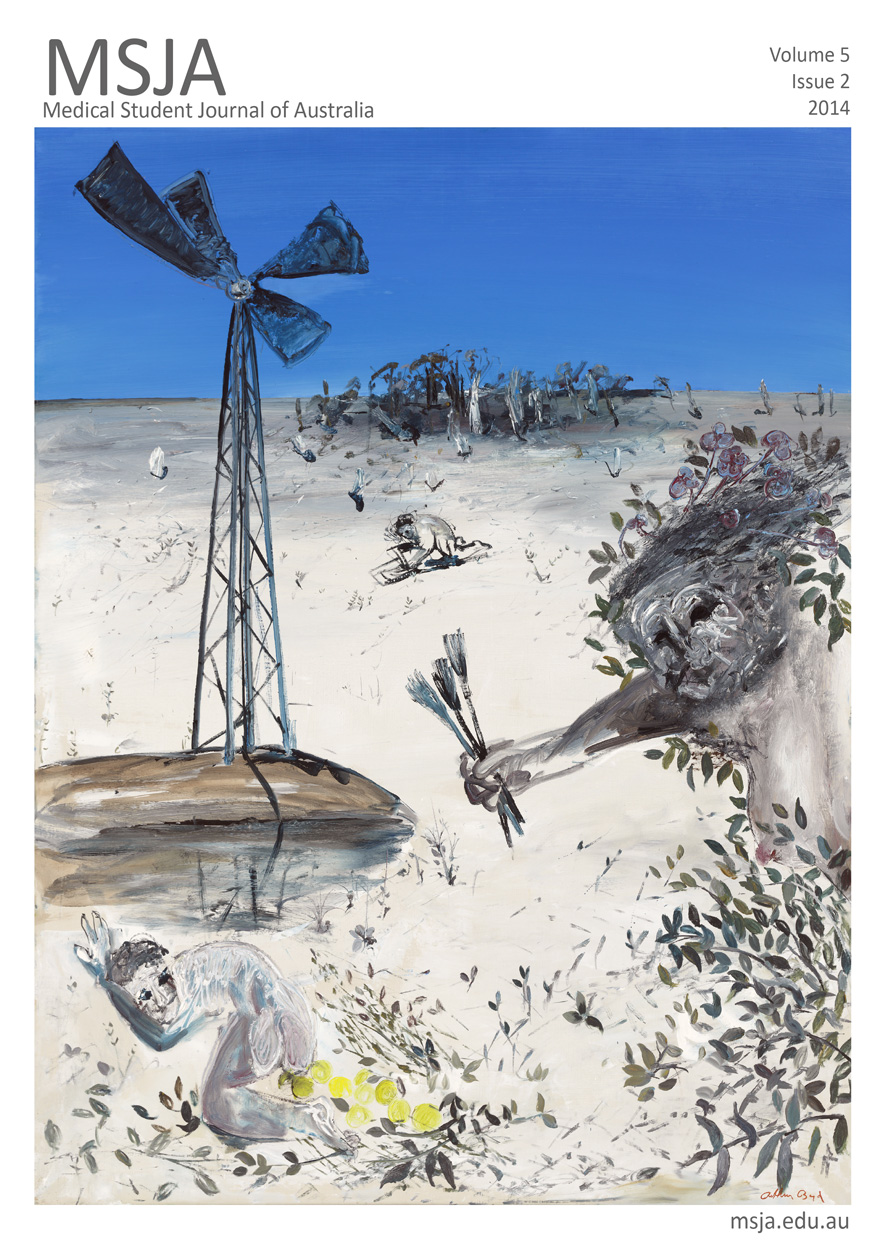Journals
Browse or search a variety of academic journals maintained by ANU Press, or find out more about the journal authors. Download the book for free or buy a print-on-demand copy.
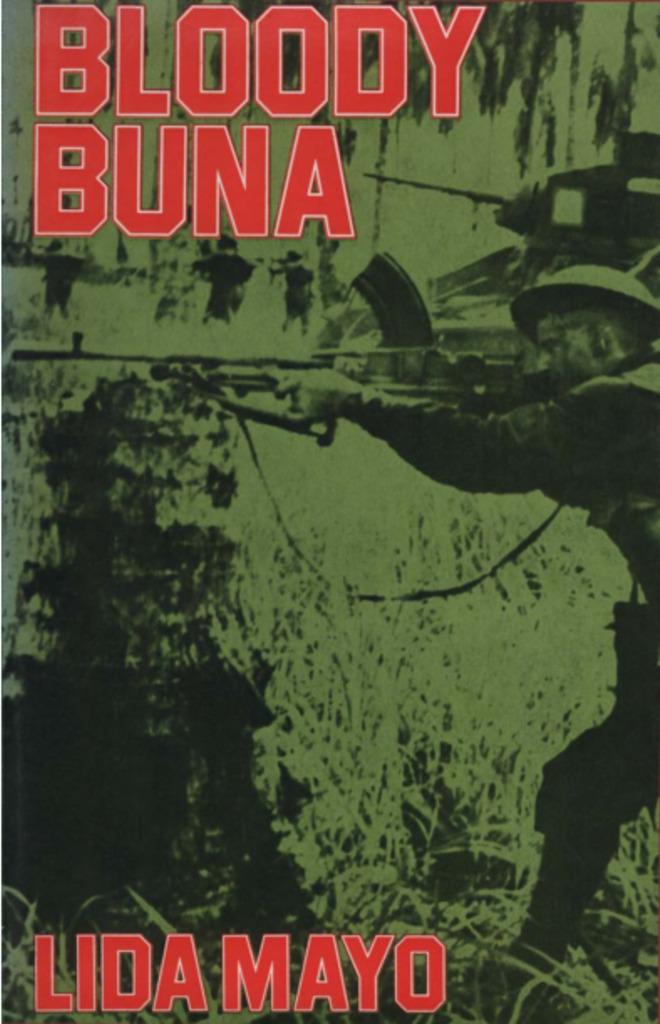
Bloody Buna: the campaign that halted the Japanese invasion of Australia, maps drawn by A.S. Hardyman »
Publication date: 1975
In 1942 the Australian 16th and 25th AIF Brigades, supported by militiamen of the 3rd Battalion, forced the Japanese back over the KokodaTrail and into a narrow strip in the Buna-Gona-Sanananda area along the northern New Guinea coast. It was decided the Australians would clear the Gona-Sanananda area; the Americans would attack Buna. The inexperienced 32nd U.S. Infantry Division gathered south of Buna, and on 19 November 1942 the confident main American assault began. The veteran Japanese jungle fighters, recently reinforced, were ready. They had constructed an elaborate defensive system of dirtcovered coconut-log bunkers; swamps; flooded rivers, rain, mud and the kunai hampered the Americans; thickly-foliaged trees made air strikes nearly impossible, and faulty intelligence reports gave a totally inaccurate assessment of the Japanese strength. By December the attack on Buna had halted. Poorly trained and equipped, discipline gone, hungry, dirty and ill, the Americans were reluctant to move. Lieutenant-General Eichelberger, sent in by the impatient Supreme Commander, General MacArthur, ordered a major reorganisation, and new attacks were mounted. But the bloody Buna battle again ground to a stalemate. Australia's 18th Brigade and other troops, equipped with long overdue tanks and artillery, joined in whilst other Australian forces pressed on with their task at Gona-Sanananda. The Japanese fought with fanatical resolve but the weight of the Australian-American attacks finally told, and on 2 January 1943 the Americans took Buna government station to end one of the most desperate campaigns of the entire Pacific war. In Bloody Buna senior U.S. Army historian Lida Mayo describes the affair in authentic and gripping detail. Her narrative is sharpened with interviews and private accounts, and she leaves no doubts about the crushing mental pressures, physical ordeals, brutalities, and macabre horrors of the struggle. Nor does she fail to analyse the problems created by the remoteness of higher command from the scene of action.

The classification of Australian local authorities »
Publication date: 1975
Published Press Archives http://press.anu.edu.au/node/2939 1885_114792.jpg ANU Press The classification of Australian local authorities Monday, 18 August, 1975 Not available Archive Scholarly Information Services Harris, C. P.

Building a terrace »
Publication date: 1975
Published Press Archives http://press.anu.edu.au/node/3469 1885_114713.jpg ANU Press Building a terrace Monday, 18 August, 1975 Not available Archive Scholarly Information Services Brissenden, R. F

Constitutional responsibility for education in Australia »
Publication date: 1975
The Australian Constitution makes no reference to education as one of the responsibilities transferred by the states to the central government. Yet the Australian Government is very much involved, both in financing education in the states and also in its future development. Is the Australian Government usurping states{u2019} rights? This book examines the development of central government involvement in education, and its justification, in particular the {u2018}benefits to students{u2019} clause in the 1946 social services amendment to the Constitution. Leading court cases concerning these powers, decided in the High Court of Australia, suggest that the central government does have authority for its actions. Clearly, the book is of fundamental importance for educationists, states-righters, and lawyers, amongst others, and its implications are far reaching.

Contention and dispute: aspects of law and social control in Melanesia »
Publication date: 1974
Law pervades the social, political, and economic aspects of the lives of all people in all communities. In Papua New Guinea, as in many emerging nations, however, law is not always the panoplied abstraction of western nations; rather, it is the customary law, in which discussions and arguments about disputes within the groups are carried on until consensus is reached. Contention and Dispute presents several case histories from different parts of Papua New Guinea showing what people argue about and how they settle their differences. Each is analysed in terms of its context of place, social conditions, disputants, and personalities. Each exemplifies customary law in action, in native courts that are often vigorous, downright, earthy - and devious. Each is a community affair, utterly remote from the formality of western courts, and is at once a means of restoring the status quo and a platform for personal and political ambitions. A fundamental problem for Papua New Guinea today is to lay the foundations for a nationally acceptable system that will combine the legal needs, in national and international terms, with a customary law that is different from but not inferior to introduced law. This book provides an essential background for the solution.
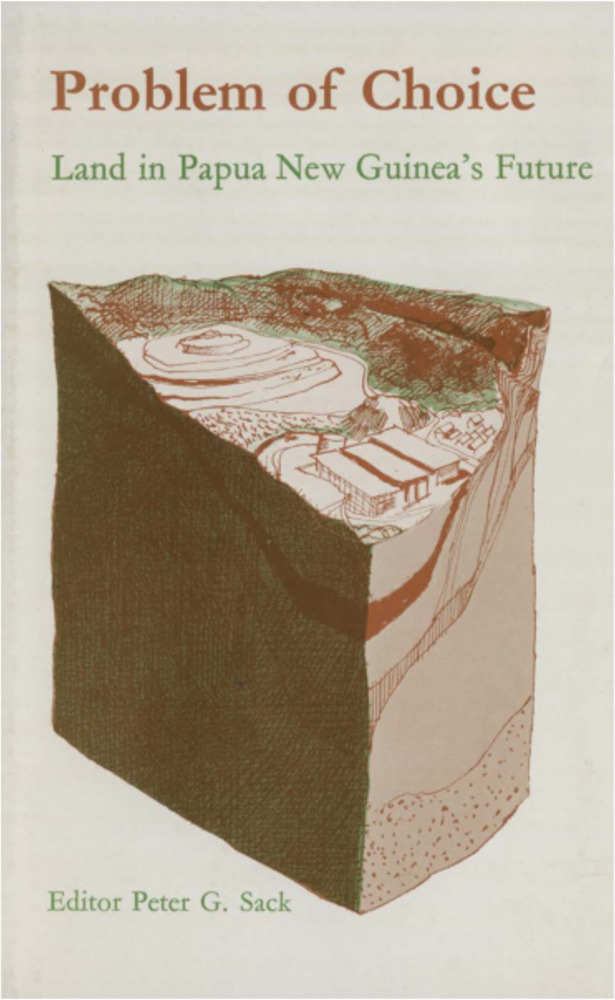
Problem of choice: land in Papua New Guinea's future »
Publication date: 1974
For the peoples of Papua New Guinea land is overwhelmingly important, not only as the sole means of life but also for what it means in their culture. It is inalienable; it came to them from all their forebears, and it will belong to all their descendants. Its emotional and spiritual significance evokes from them a religio-mystical response completely alien to the Western attitude that land is just another commodity. Yet, for a developing nation, land is also a commodity - to be bought and sold for large-scale agriculture, to be mined, to be used for commerce and agriculture, schools and cities. Thus there is an inherent conflict between traditional and potential uses reflecting a profound conflict of values and attitudes. As Papua New Guinea approaches independence, no problem is of greater importance than the role of land, for no other issue is potentially so violently divisive. Is it to be a national estate? Is it to be owned and used individually, co-operatively, corporately? What will be the impact on the whole social fabric of the country and the lives of its people? In essays expressing every shade of opinion from expatriate detachment or involved commitment and conviction to indigenous bewilderment, rage, frustration, or sense of betrayal, the authors in this book examine some aspects of these extremely complex problems. For the future unity and security of the country the answer is crucial. It is one that the Papua New Guineans alone must make. But there is no easy answer, no simple solution, to their Problem of Choice.
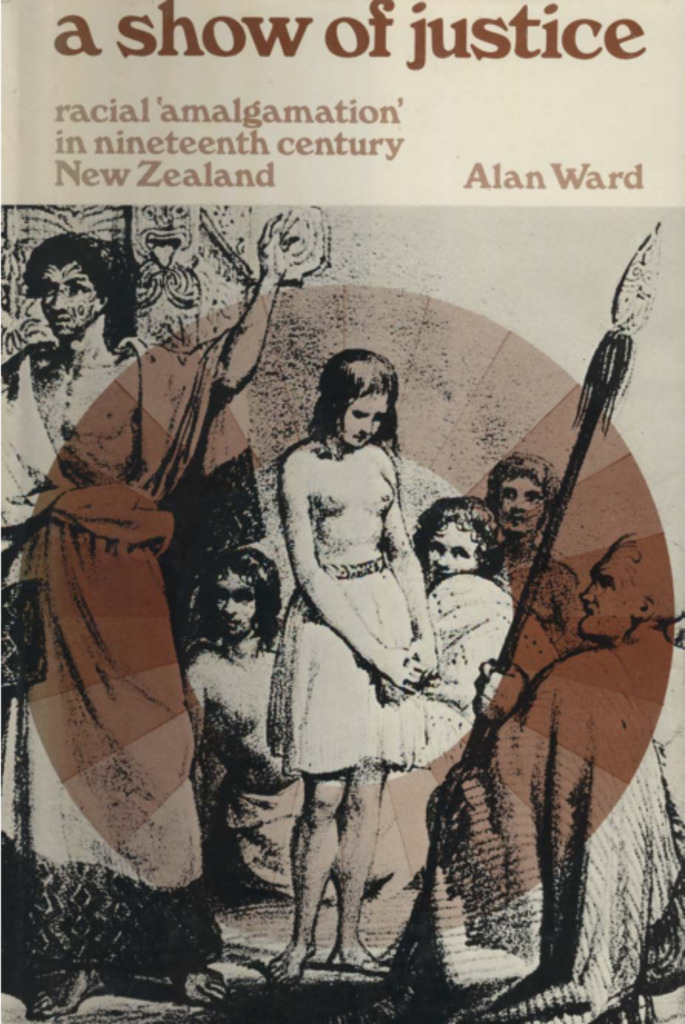
A show of justice: racial 'amalgamation' in nineteenth century New Zealand »
Publication date: 1974
A Show of Justice looks at New Zealand in the nineteenth century when British officials and humanitarians attempted through assimilation to save the Maori from destruction by the tide of European settlement. This policy, and the special administrative and judicial machinery set up to implement it, helped avert the situations in which the American Indians and Australian Aborigines find themselves. Nevertheless, it led to the subjugation of the Maori under {u2018}a show of justice'. Using the records of the old Native Department, Dr Ward probes the attitudes of Maori and settlers towards each other. He shows how, in practice, the settlers both refused to recognise Maori political and judicial institutions and, lest it enabled them to keep their lands closed to settlement, denied them a genuine share in the new state. He reveals, too, how under settler pressure the special machinery set up to involve the Maori was hastily abolished, a step which has since contributed to keeping the two races apart. Maori are now demanding honest answers to many unanswered questions. In this book they, and all concerned with the problems of race relations, will find a basis for some of the answers. And at a time when nations are being made acutely aware of the aspirations of their minority races, national leaders would benefit from a long hard look at New Zealand's experience.
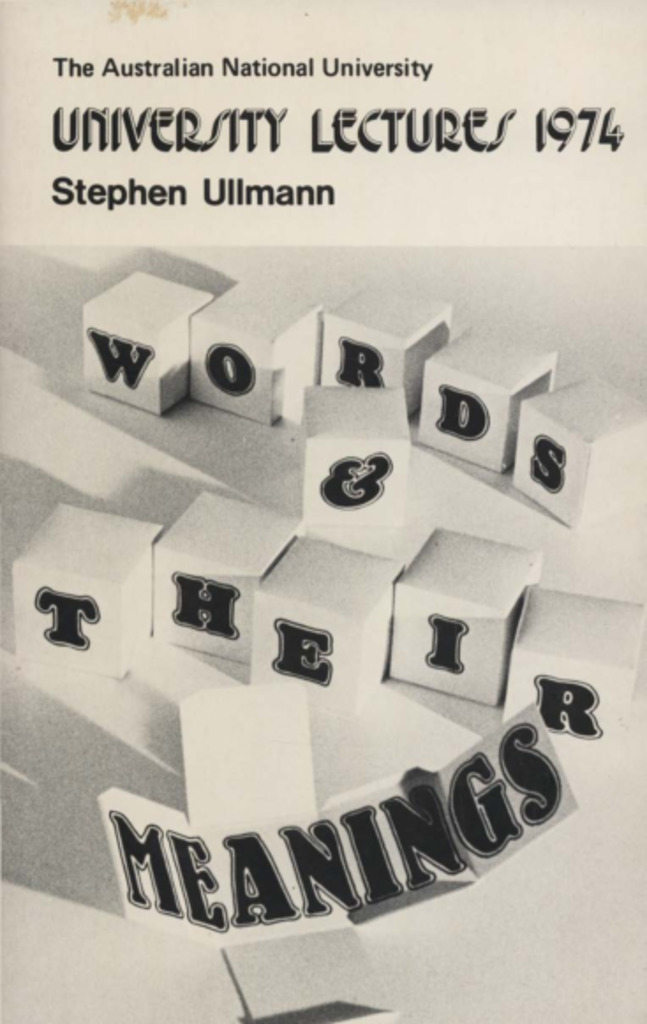
Words and their meanings »
Publication date: 1974
Published Press Archives http://press.anu.edu.au/node/3343 1885_114904.jpg ANU Press Words and their meanings Sunday, 18 August, 1974 Not available Archive Scholarly Information Services Ullmann, Stephen
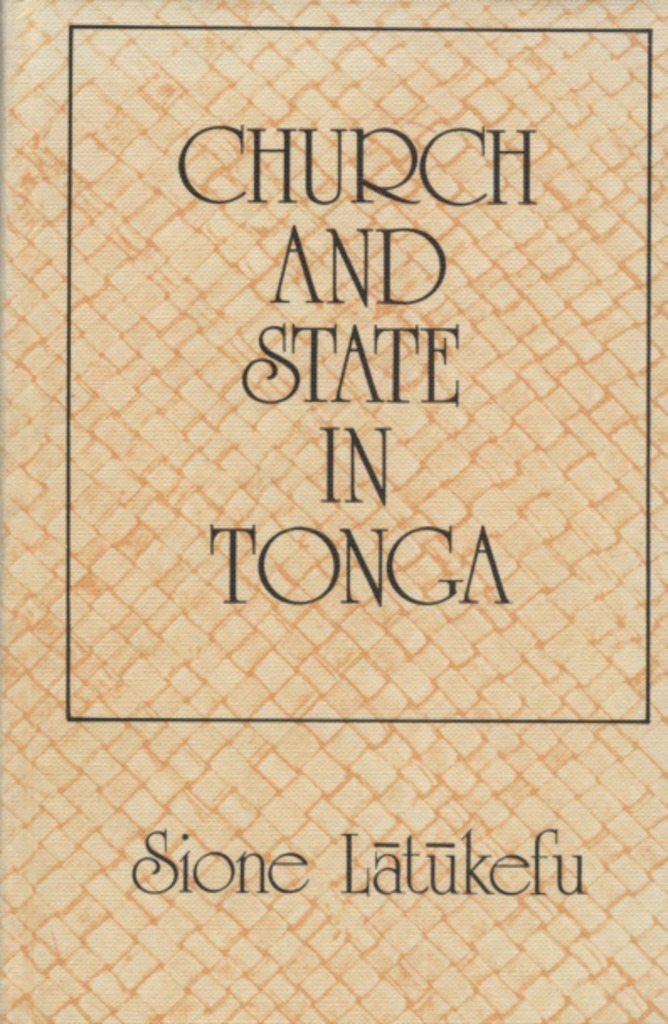
Church and state in Tonga: the Wesleyan Methodist missionaries and political development, 1822-1875 »
Publication date: 1974
Published Press Archives http://press.anu.edu.au/node/3119 1885_114697.jpg ANU Press Church and state in Tonga: the Wesleyan Methodist missionaries and political development, 1822-1875 Sunday, 18 August, 1974 Not available Archive Scholarly Information Services L??t??kefu, Sione

'Not a white woman safe': sexual anxiety and politics in Port Moresby, 1920-1934 »
Publication date: 1974
Sexual anxiety, bordering on panic, in the Australian colonial town of Port Moresby - 'Port' - during the 1920s is the theme of this book. Port Moresby was more white, more Protestant, more homogeneous than comparable towns like Darwin or Rabaul. Its Papuan inhabitants were considered low on the ladder of civilisation and were despised for trying to climb up it. At the same time they were feared. Liaison with a black, demeaning to a white man, was regarded as defilement to a white woman, and the Papuans were believed to be primitives, unable to control their sexual appetites. Panic and political passion forced Administrator Hubert Murray, whose native policy was criticised as {u2018}lenient{u2019}, to introduce the savagely discriminatory White Women's Protection Ordinance. It stated that anyone who raped or attempted to rape a white woman or girl would be hanged. Mrs Inglis tells the stories of two Papuans convicted under the Ordinance and shows how guilt over the conduct of the trials and over the public hanging of one of the m en clouded the judgment of the white residents so that they became incapable of telling the truth about the incidents, then or later. She questions their belief, ironically shared by Papuans, that white women, sometimes unwittingly, provoked the attacks by immodest behaviour and demonstrates that the Ordinance was the logical outcome of hurt male prestige, authority, and racial pride. The Ordinance was revoked in 1958.

The broken years: Australian soldiers in the Great War »
Publication date: 1974
Before the First World War most Australians shared the emotions and traditions of the British Empire. Proud of their British heritage, anxious to raise the Imperial status of Australia, they were eager to fight and, if need be, to die in defence of their race and country. But the horror and tragedy of the conflict brought fundamental changes in outlook. Many of the pre-war enthusiasms persisted, but the days of unquestioning allegiance to Empire were beginning to come to an end, to be replaced by the bittersweet tradition of Anzac. Dr Gammage shows how and why these changes took place. Using the diaries and letters of one thousand front-line soldiers of the First Australian Imperial Force, most of them now part of a unique collection housed in the Australian War Memorial in Canberra, he reconstructs the motives and expectations with which these men volunteered and the experiences they encountered. He highlights and examines the new attitudes to war and to the homeland that developed and foreshadows the important effects in Australia of the changed outlook brought home by the survivors. Those who have returned from war will recognise immediately the raw realities faced by the 'diggers', the growing disillusionment, and the hopes for the future. Those with fathers, husbands, or brothers who served, and all those concerned with what happens to men at war, cannot fail to be moved by the simple dignity of the men{u2019}s accounts, or by the understated courage with which they wrote to their families of the miseries they endured. This book, written with sensitivity and scholarly care, must be read if we are to understand war and its impact on the ethos of a nation.
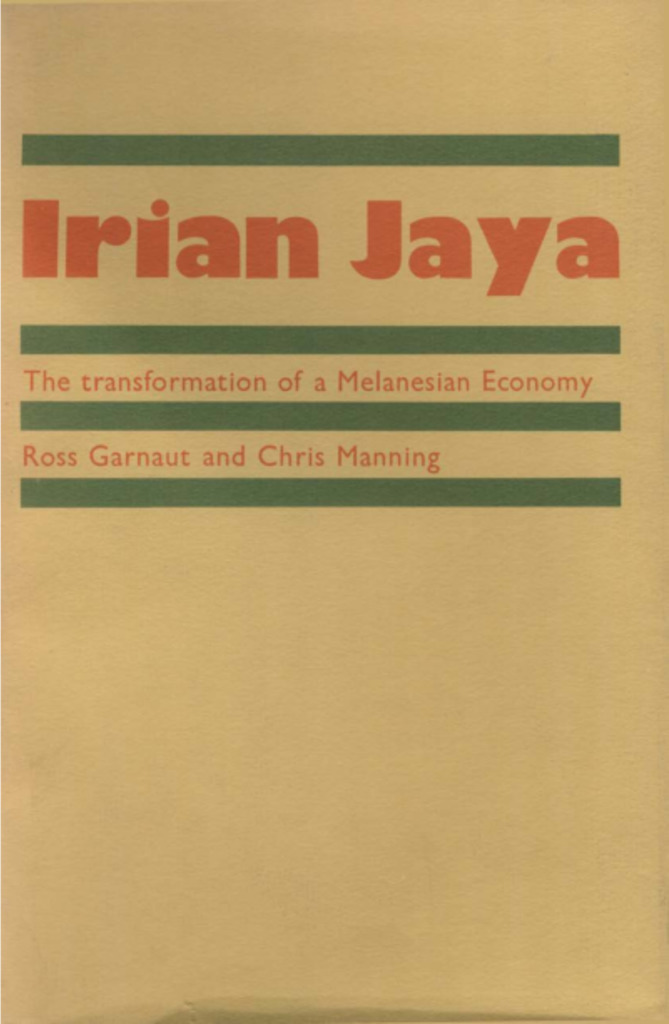
Irian Jaya: the transformation of a Melanesian economy »
Publication date: 1974
In 1963 Indonesia took over the former Dutch colony of West New Guinea. In the decade since, this large resource-rich Melanesian area, now Irian Jaya, has undergone rapid change to become an integrated province of the comparatively resource-poor Republic of Indonesia. Under the culturally alien Dutch administration change was slow and felt predominantly in the towns. Under the equally alien Indonesian administration the pace of change has accelerated and the effects have been more dramatic, even traumatic. Irian Jaya towns have now been substantially integrated into the Indonesian system - development programs have had marked effects on education, money, labour and commodity markets, transport and communications, and the utilisation of forest, mineral and fish resources. These effects have not always benefited the Irianese people and the gap between the modern economy and the villages still pursuing a Melanesian way of life is increasing. The Irian Jaya experience, traced in this book, is of great importance to those concerned with the future of Papua New Guinea, of the Melanesian economies to its east, and of the Southeast Asian economies to its west. Little use has so far been made of this rich source of comparative data and the authors have here, for the first time, assembled in a concise and interesting form Irian Jaya{u2019}s responses to its experience.
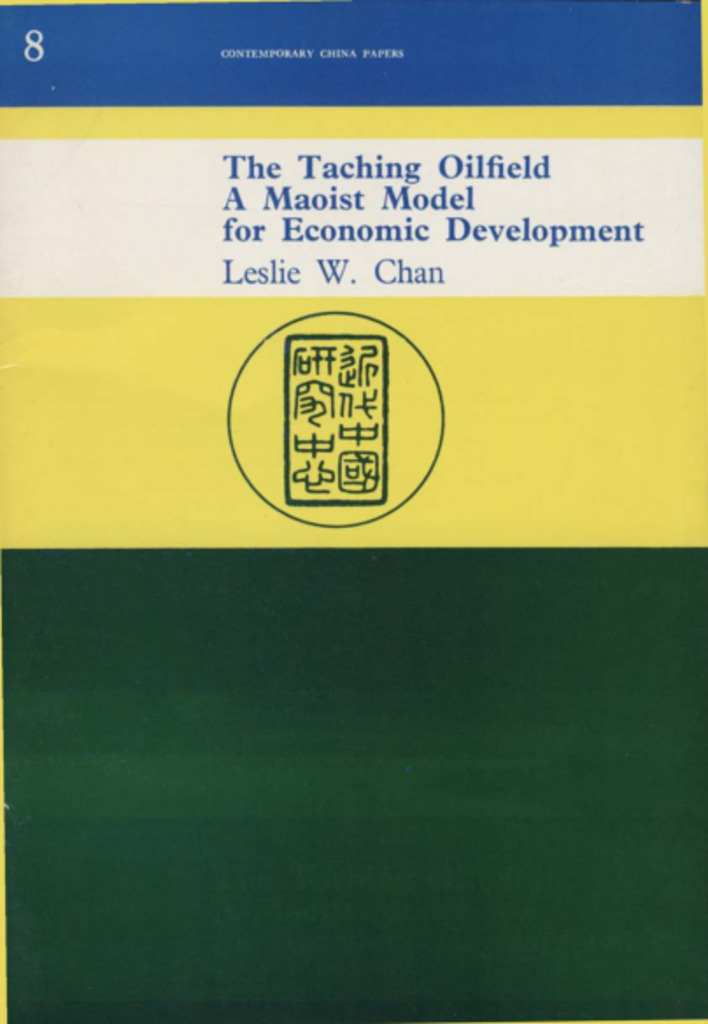
The Taching oilfield: a Maoist model for economic development »
Publication date: 1974
The Taching oilfield, discovered in the late 1950s, has become China's main producer of crude oil and a national model for all industry. This paper relates the history of this remarkable complex and its development from its discovery, through the disruptions of the Cultural Revolution up to the leading position it holds today. Mrs Chan analyses Taching's pattern of development and discusses its successes and failures. She extends her discussion to embrace Mao Tse-tung's aims in economic development and also draws some conclusions about the feasibility of Maoist economic development for China. Because of the close interrelationship between social, political and economic development that exists there this paper will be of interest to all observers of China, particularly those concerned with its economic development.
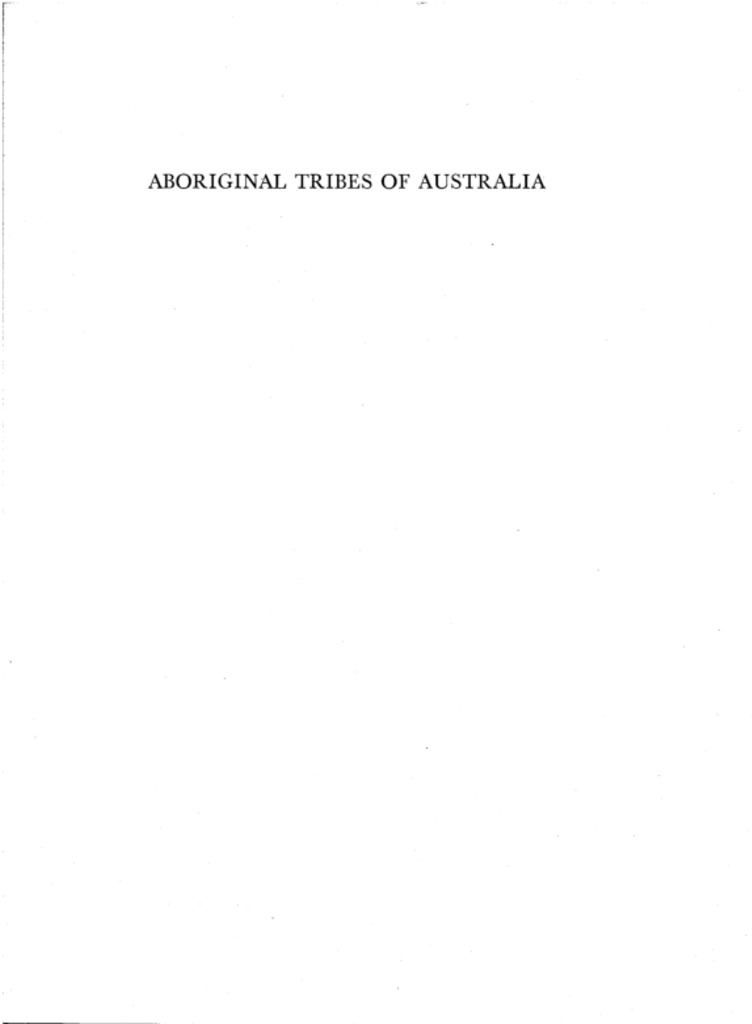
Aboriginal tribes of Australia: their terrain, environmental controls, distribution, limits, and proper names »
Publication date: 1974
Published Press Archives http://press.anu.edu.au/node/3203 1885_114913.jpg ANU Press Aboriginal tribes of Australia: their terrain, environmental controls, distribution, limits, and proper names Sunday, 18 August, 1974 Not available Archive Scholarly Information Services Tindale, Norman B.

Aborigines in the Northern Territory cattle industry »
Publication date: 1974
Perhaps nowhere in Australia have working and living conditions for Aborigines been so bad as on Northern Territory cattle stations. Though the Aborigines{u2019} skill in handling cattle is acknowledged by their white employers, rarely have they gained recognition in any material way. None were paid full wages, many were fortunate if they received any cash wages at all, almost all lived in appalling conditions, and many were subjected to physical violence. These facts emerge clearly from Dr Stevens{u2019}s thorough research into the conditions obtaining on Territory pastoral properties in the 1960s. During surveys in 1965 followed up in 1967, Dr Stevens questioned employers and both black and white workers in the industry, eliciting some revealing replies. It was apparent that the Aboriginal workers were fully aware of their degraded position and the way in which they were exploited. Where possible Dr Stevens visited the Aboriginal station {u2018}camps{u2019}, though he met with opposition from some station owners, reluctant to allow him free access. In almost all of them the living conditions were primitive, the best of accommodation being little more than a corrugated iron hut. Few camps had running water or cooking facilities. In the growing awareness of the Aborigines{u2019} plight in Australia, this book is an important testimony of the conditions in which many lived and worked, conditions that must no longer be allowed to exist.

The Marquesan journal of Edward Robarts, 1797-1824 »
Publication date: 1974
Edward Robarts was among other things whaler, beachcomber, Tahitian rum producer, Tuamotuan pearler, butler in Penang, gardener and policeman in Calcutta. He deserted his ship in 1798 in the Marquesas, and lived there as a native, where he was adopted by the chiefly families, married a chief's daughter, and fought in battle as a Marquesan warrior. He spent longer in the islands than did most eighteenth century beachcombers, and got to know more about Polynesian society than did most other early observers. After leaving the Marquesas Robarts was employed in Penang as butler to a relative of the Raffles family. Raffles introduced him to Dr Leyden, under whose patronage he wrote this Journal. Now published for the first time, it is as Robarts wrote it, although Professor Dening has made some minor concessions to readability, as well as providing the invaluable introduction and annotations. Robarts's account of his Marquesan life is the single richest source of material yet published on this least known and unders tood of all Polynesian people. The scholar will find that Robarts{u2019}s ethnography modifies some later preconceptions about the Marquesas, and throws new light on the processes of cultural change in the Pacific. For the general reader the book is an enthralling autobiography of a common man who led a most uncommon life.
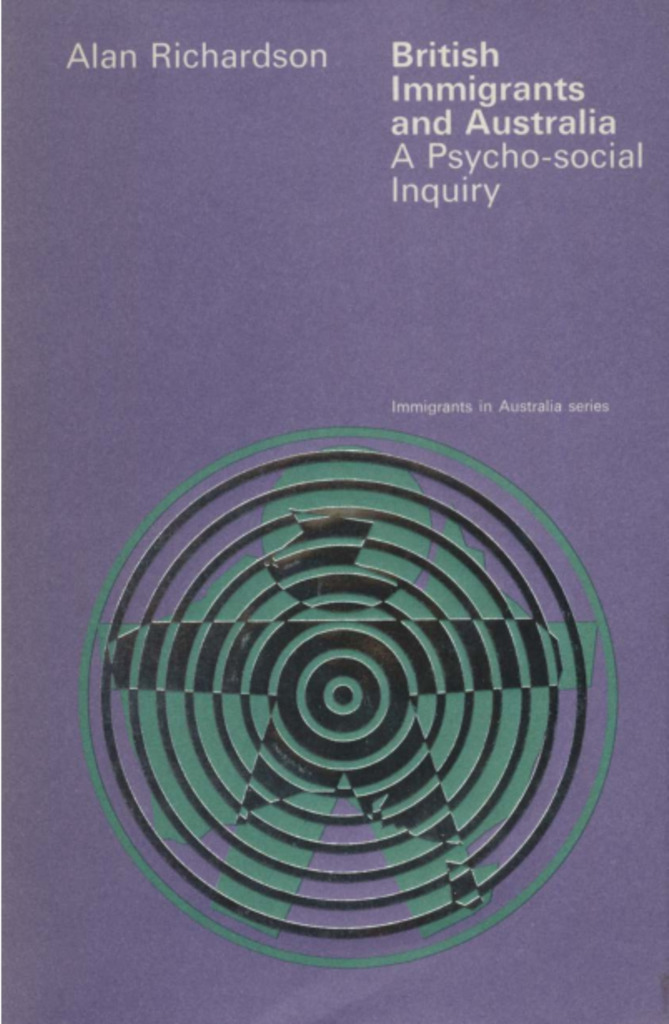
British immigrants and Australia: a psycho-social inquiry »
Publication date: 1974
Since World War II many thousands of Britons have emigrated to Australia, most of them to settle permanently but some to return home or move on elsewhere. Why they decided to emigrate and what changes in beliefs, attitudes and behaviour occurred after their arrival in Australia are the subject of this book. Basing his work largely on an extensive survey among assisted passage British migrants before they left Britain and after intervals of two and seven years in Australia, Dr Richardson examines the various stages through which immigrants pass in the process of settling down in their new country and he discusses the intriguing questions of why some British immigrants change to the point where they consider themselves more Australian than British while others remain inalienably British. This is an important work for theorists of immigrant behaviour - drawing as it does on the findings of other researchers in the field - and for administrators responsible for the welfare of British immigrants in Australia. The immigrants themselves will find it helpful to discover that they are not alone in their problems and perplexities.

The Australian experience: critical essays on Australian novels »
Publication date: 1974
In its challenge to look afresh at sixteen novels about the Australian experience of life - novels as different as Harris's Emigrant Family, Stow's Tourmaline, Keneally's Jimmie Blacksmith or White's Vivisector - this book adds a new dimension to Australian literary criticism. The novels range from the nineteenth century to today; their subjects are as diverse as colonial utopianism, the savagery of the convict system, the treatment of primitive peoples, war and nationalism. Yet through them all runs one universal, human theme: the search for self-understanding. Lucid and informed, on occasion provocative and contradictory, this collection of critical essays is essentially an exercise in discovery or rediscovery by many distinguished writers. Not all readers will accept these highly personal revaluations - many will be exasperated by them - but none will fail to enjoy their challenge.
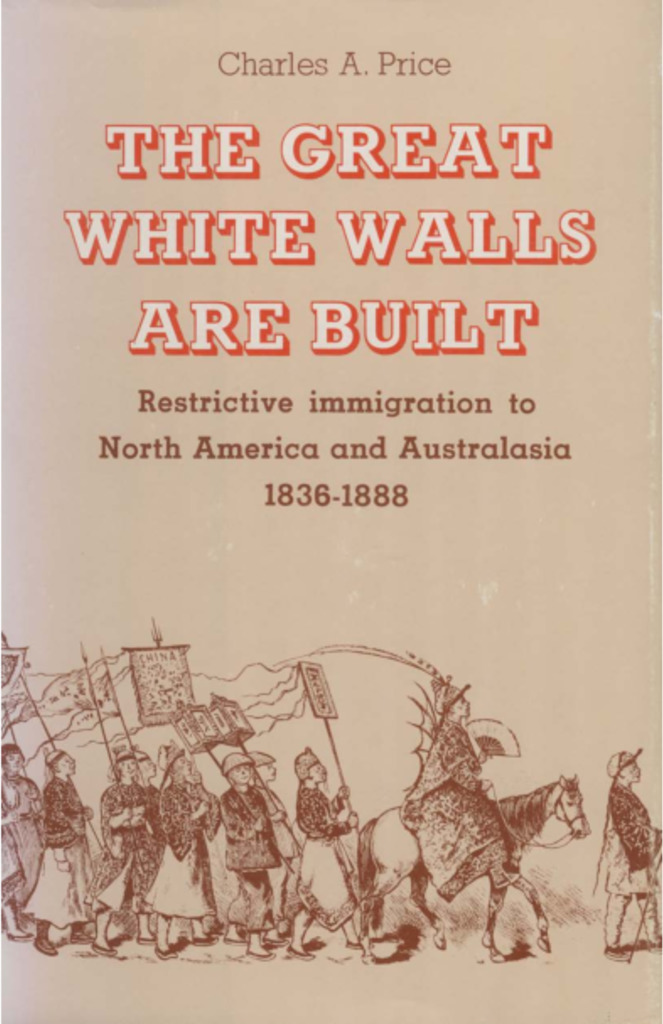
The great white walls are built: restrictive immigration to North America and Australasia, 1836-1888 »
Publication date: 1974
Before the 1840s only a trickle of Cantonese 'coolies and labourers' had come to the Pacific region. But in the great goldrushes of 1848 to 1854 in California, Eastern Australia, New Zealand, and British Columbia the trickle became a flood. When gold began to peter out, the Chinese remained, enjoying a brief period of humanitarian liberalism. But in the 1870s renewed immigration aroused fear of slave labour and racist antipathy towards 'inferior' races. One by one the four areas erected barriers against the Chinese, by severe restriction on immigration and harsh discriminatory control of the settlers. In describing their evolution and growth Dr Price distinguishes common sources for what seem purely local grievances, and shows how widespread everyday pressures gave rise to policies apparently baseless and unnecessary. These policies were the great white walls', analogous with China's Great Wall built to keep out the barbarians. This humane study looks at coloured migration from the point of its victims as well as from that of the dominant white society. It shows that the notorious 'White Australia Policy' is not unique but had its counterparts in the other regions of the Pacific. It adds a new dimension to understanding the political, social, economic, and moral forces that caused savage and widespread restrictions on coloured immigration.

The economics of population: an introduction »
Publication date: 1974
The potentially explosive force of population growth poses questions to which the answers given by scientists of recent decades have often generated more heat than light. In this book we have an economist's approach to the problem. Professor Pitchford discusses the long-run relationships between a country's population and its economic development, exploring ways in which population policy can be directed towards improving economic welfare. Assuming no specialised knowledge of economics, Professor Pitchford guides his reader lucidly through the concepts of production and employment to an important reformulation of the concept of optimum population. With the help of clear diagrams he introduces the various theories of population change and standard models of population processes before returning to optimum population and practical policies for attaining balanced states. Throughout, particular stress is laid on the place in economic theory of both renewable and exhaustible resources. This is a book for students of economics, demography and ecology, for policy makers and for the growing body of people showing intelligent concern for the problems of an increasingly crowded planet.

The New Guinea memoirs of Jean Baptiste Octave Mouton »
Publication date: 1974
In 1880 young Jean Baptiste Octave Mouton left Belgium and his trade as wigmaker's apprentice to better his prospects in the Pacific. With his father, a leather worker, he joined the rascally Marquis de Rays's ill-fated colonising venture in New Ireland and stayed to become a wealthy trader and copra planter. Mouton was refreshingly free of the pompous superiority of most Europeans. He was not misled by his own preconceptions but sympathised with native feelings and perceived something of the relationship of custom to the institutions of kinship and authority. Indeed he married a local woman and adopted certain local practices - inevitable incurring the disapproval of his European fellow-settlers. His 'Memoirs', impassive, matter-of-fact and impersonal in style, illustrate a dramatic theme: the impact of European arrival on small, isolated but stable communities, and the disruption caused to traditional ways of life. Recollections such as these throw valuable light on a poorly-documented period of New Guinea history and provide an account of such colourful figures as Thomas Farrell, the legendary Queen Emma - and Mouton himself.
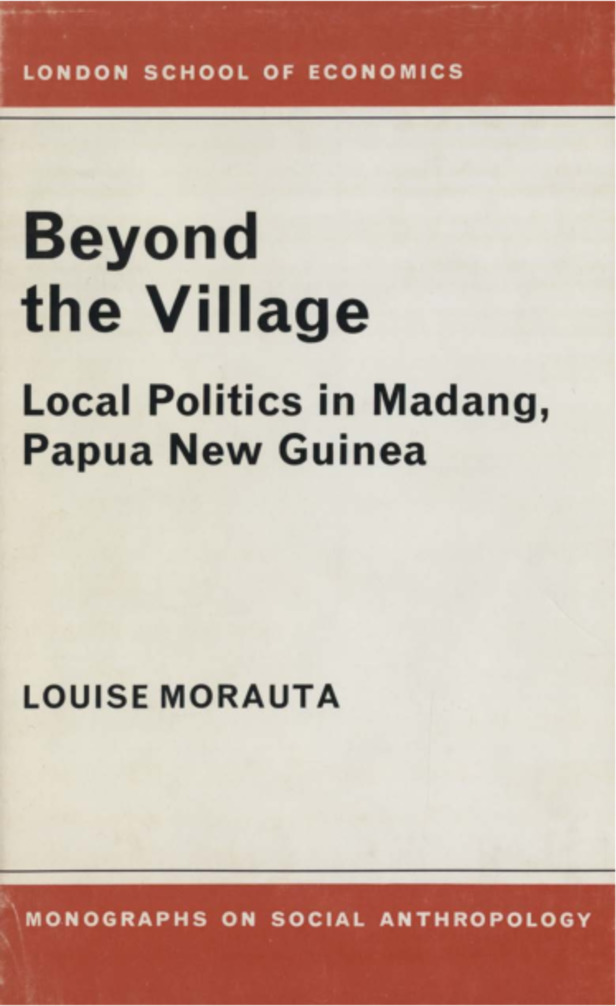
Beyond the village: local politics in Madang, Papua New Guinea »
Publication date: 1974
Papua New Guinea is on the verge of political independence and this volume gives important insights into the way its inhabitants are dealing with the new political institutions that have impinged upon them in the last years of colonial rule. The title suggests both the scope of the book and its main theme: it is not a study of a single village but of a district; and recent developments have widened the political horizons of its inhabitants in interesting ways. Dr Morauta shows how the people of Madang interpret the institutions of political representation; and her book gives continuity to previous studies, for it also reports on the activities of the now famous cargo cult leader Yali and his supporters. Yali{u2019}s cult has become virtually institutionalised and provides opportunities that compete with the administration{u2019}s political structures for the individual{u2019}s alignment.
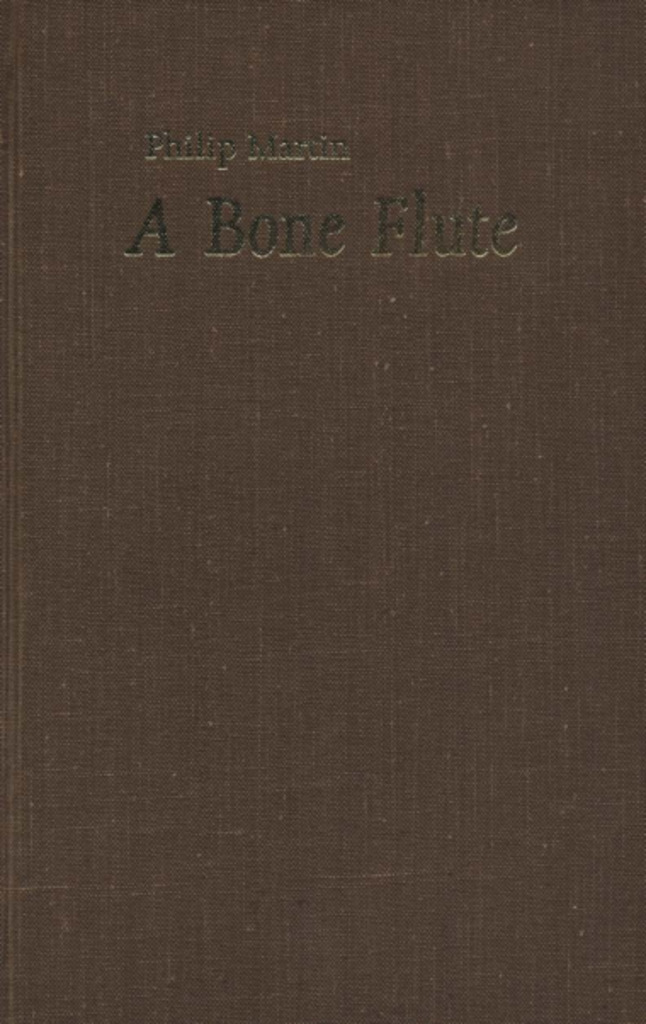
A bone flute: poems »
Publication date: 1974
Published Press Archives http://press.anu.edu.au/node/3323 1885_114924.jpg ANU Press A bone flute: poems Sunday, 18 August, 1974 Not available Archive Scholarly Information Services Martin, Philip John Talbot

Voting for the Australian House of Representatives, 1901-1964 »
Publication date: 1974
This book makes available, for the Commonwealth of Australia, detailed election results from which Commonwealth sections of the Handbook of Australian Government and Politics (ANU Press, Canberra, 1968) were compiled. For 1919 and subsequent years it gives the official result for each candidate, together with his party affiliation and the percentage of the total vote he received. After 1922 it also gives the distribution of preferential votes. The official results are scattered through volumes of Commonwealth Parliamentary Papers and Commonwealth Parliamentary Handbooks; the former do not show party affiliation; the latter show it only for recent years for all candidates orfor successful candidates for all elections. Thus this work brings together a vast amount of widely scattered and detailed information, which will make it a basic research tool for students offederal history and politics of the period.
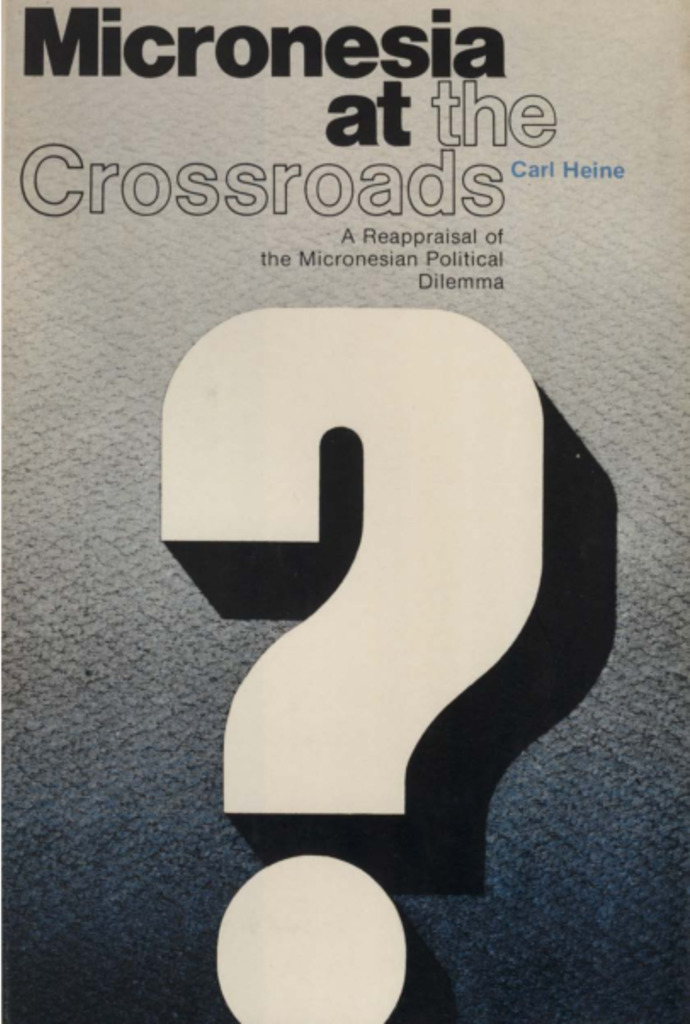
Micronesia at the crossroads: a reappraisal of the Micronesian political dilemma »
Publication date: 1974
Covering an area of the Pacific Ocean larger than the continental United States, the more than 2,000 islands and atolls of Micronesia - a United Nations strategic trust territory under U.S. trusteeship - are emerging as a political entity. Their history since the Spanish discovery in the seventeenth century is a parade of colonial rule - Spanish, German, Japanese, and now American. Today, the many islands and their diverse peoples are confronting the awesome task of determining their political future. Hampered by differences in culture and language, and by attitudes fostered under years of paternalism, the islanders must begin to develop an identity as Micronesians. As most commentary on Micronesia has been written by outsiders, this book is most welcome - an evaluation and viewpoint of a Micronesian who has been a student of Micronesian history and a close observer of the territory{u2019}s political development. In Carl Heine{u2019}s view, Micronesia is standing at the crossroads between political decolonization and autonomy or further dependence on a "neglectful" trustee, the United States. The question becomes, which road to nationalism should be taken? Here the author attempts to provide a basis for further discussion of Micronesia{u2019}s future, and offers alternative solutions: complete independence from the United States; a return to traditional ways of life; the formation of a Free Associated State of Micronesia aligned with the United States. As he comments, there are those in Micronesia who prefer Coca-Cola to coconuts, and others who prefer coconuts to Coca-Cola. Whatever the final resolution, both of these preferences must be respected and accommodated. The problems facing Micronesia are immense and pressing. Here in straightforward language is the view of the dilemma by one man - a man completely immersed in the struggle to realize the rights of 100,000 people to a better life.
ANU Press Journals
Aboriginal History Journal »
Since 1977, the journal Aboriginal History has pioneered interdisciplinary historical studies of Australian Aboriginal people’s and Torres Strait Islander’s interactions with non-Indigenous peoples. It has promoted publication of Indigenous oral traditions, biographies, languages, archival and bibliographic guides, previously unpublished manuscript accounts, critiques of current events, and research and reviews in the fields of anthropology, archaeology, sociology, linguistics, demography, law, geography and cultural, political and economic history.
Aboriginal History Inc. is a publishing organisation based in the Australian Centre for Indigenous History, Research School of Social Sciences, The Australian National University, Canberra.
For more information on Aboriginal History Inc. please visit aboriginalhistory.org.au.
Submission details
Please send article submissions to aboriginal.history@anu.edu.au.
Articles of about 7,000 words in length (including footnotes and references) are preferred, but submissions up to 9,000 words will be considered. Please submit an electronic version of the paper (text only without embedded images or scans) in Microsoft Word or RTF format, along with a short abstract and author biography as a separate document.
ANU Historical Journal II »
The ANU Historical Journal II (ANUHJ II) is an open-access, peer-reviewed academic history journal of the ANU College of Arts and Social Sciences and the ANU College of Asia and the Pacific. It is a revival of the ANU Historical Journal, which was published between 1964 and 1987. Contributors to the first journal included academics such as Ken Inglis, Manning Clark, John Ritchie and Oliver MacDonagh along with then-emerging scholars Iain McCalman, Michael McKernan, Margaret George, Coral Bell, John Iremonger, Alastair Davidson, Susan Magarey and Rosemary Auchmuty. As well as upholding the Journal’s commitment to the work of students and early career researchers, the ANUHJ II has expanded its focus to include memoirs, short articles and long-form book reviews.
The ANUHJ II invites submissions from students, graduates and academics of any Australian university.
For more information about the ANUHJ II, please visit anuhj.com.au
Australian Journal of Biography and History »
The Australian Journal of Biography and History is an initiative of the National Centre of Biography (NCB) in the Research School of Social Sciences at The Australian National University. The NCB was established in 2008 to extend the work of the Australian Dictionary of Biography and to serve as a focus for the study of life writing in Australia, supporting innovative research and writing to the highest standards in the field, nationally and internationally. The Australian Journal of Biography and History seeks to promote the study of biography in Australia. Articles that appear in the journal are lively, engaging and provocative, and are intended to appeal to the current popular and scholarly interest in biography, memoir and autobiography. They recount interesting and telling life stories and engage critically with issues and problems in historiography and life writing.
The journal publishes peer-reviewed articles on Australian historical biography, including biographical studies, studies relating to theory and methodology, and the associated genres of autobiography, life writing, memoir, collective biography and prosopography. We are especially interested in articles that explore the way in which biography and its associated genres can illuminate themes in Australian history, including women in Australian society, family history, transnational networks and mobilities, and Indigenous history.
Submission Details
Please send article submissions or abstracts to the Editor, Dr Malcolm Allbrook, National Centre of Biography, The Australian National University. Email: Malcolm.Allbrook@anu.edu.au. Articles should be in the range of 5,000 to 8,000 words (excluding footnotes), although longer submissions may be considered after consultation with the Editor. Style and referencing: please use footnotes in Chicago style, and follow British spelling.
East Asia Forum Quarterly »
East Asia Forum Quarterly grew out of East Asia Forum (EAF) online, which has developed a reputation for providing a platform for the best in Asian analysis, research and policy comment on the Asia Pacific region in world affairs. EAFQ aims to provide a further window onto research in the leading research institutes in Asia and to provide expert comment on current developments within the region. The East Asia Forum Quarterly, like East Asia Forum online, is an initiative of the East Asia Forum (EAF) and its host organisation, the East Asian Bureau of Economic Research (EABER) in the Crawford School of Public Policy in the ANU College of Asia & the Pacific at The Australian National University.
Submission details
Unsolicited submissions to EAF are welcome. An analytic op-ed piece that is accessible to a general audience and written in crisp language is required. The preferred length of submissions is around 800 words. Submissions will be double-blind reviewed and, if accepted for publication, edited for English fluency and house style before returned for clearance by the author. EAFQ does not use footnotes but would be extremely appreciative if hyperlinks to internet sources are included wherever possible. EAFQ reserves the right to determine the title for any piece, but will not publish a piece or a title without permission. A suggested title is appreciated. If you have any further queries, or would like to submit, please contact shiro.armstrong@anu.edu.au.
Human Ecology Review »
Human Ecology Review is a semi-annual journal that publishes peer-reviewed interdisciplinary research on all aspects of human–environment interactions (Research in Human Ecology). The journal also publishes essays, discussion papers, dialogue, and commentary on special topics relevant to human ecology (Human Ecology Forum), book reviews (Contemporary Human Ecology), and letters, announcements, and other items of interest (Human Ecology Bulletin). Human Ecology Review also publishes an occasional paper series in the Philosophy of Human Ecology and Social–Environmental Sustainability.
Submission details
For information on preparing your manuscript for submission, please visit www.humanecologyreview.org. To submit a manuscript to Human Ecology Review, please visit mstracker.com/submit1.php?jc=her, or email humanecologyreviewjournal@gmail.com.
Humanities Research »
Humanities Research is a peer-reviewed, open access, annual journal that promotes outstanding innovative, interdisciplinary and multidisciplinary scholarship to advance critical knowledge about the human world and society.
The journal is co-published by the Humanities Research Centre, The Australian National University, Canberra. It was launched in 1997 and went into hiatus in 2013. In 2022, the journal is resuming publication, reflecting the continuing strength of the humanities at The Australian National University, the rapid development of the interdisciplinary, environmental and public humanities over the last decade, and the opportunities for international collaboration reflected in the resumption of international travel in 2022.
Issues are thematic with guest editors and address important and timely topics across all branches of the humanities.
International Review of Environmental History »
International Review of Environmental History takes an interdisciplinary and global approach to environmental history. It encourages scholars to think big and to tackle the challenges of writing environmental histories across different methodologies, nations, and time-scales. The journal embraces interdisciplinary, comparative and transnational methods, while still recognising the importance of locality in understanding these global processes.
The journal’s goal is to be read across disciplines, not just within history. It publishes on all thematic and geographic topics of environmental history, but especially encourage articles with perspectives focused on or developed from the southern hemisphere and the ‘global south’.
Submission details
Please send article submissions or abstracts to the Editor, Associate Professor James Beattie, Science in Society, Victoria University of Wellington, PO Box 600, Wellington 6142, New Zealand. Email: james.beattie@vuw.ac.nz.
Abstracts should be no more than 200 words, and include a list of keywords. Articles should be in the range 5,000 to 8,000 words (including footnotes), although longer submissions may be considered after consultation with the editor. Style and referencing: please use footnotes in Chicago Style, follow British spelling, and use single quotation marks only. Find out more details about Chicago Style.
Lilith: A Feminist History Journal »
Lilith: A Feminist History Journal is an annual journal that publishes articles, essays and reviews in all areas of feminist and gender history (not limited to any particular region or time period). In addition to publishing research articles on diverse aspects of gender history, Lilith is also interested in publishing feminist historiographical and methodological essays (which may be shorter in length than typical research articles). Submissions from Australian and international early career researchers and postgraduate students are particularly encouraged.
The journal first began publication in Melbourne in 1984. It is the official journal of the Australian Women’s History Network, an organisation dedicated to promoting research and writing in all fields of women’s, feminist and gender history.
For more information about Lilith, please visit www.auswhn.org.au/lilith/.
Made in China Journal »
The Made in China Journal (MIC) is a publication focusing on labour, civil society and human rights in China. It is founded on the belief that spreading awareness of the complexities and nuances underpinning socioeconomic change in contemporary Chinese society is important, especially considering how in today’s globalised world Chinese labour issues have reverberations that go well beyond national borders. MIC rests on two pillars: the conviction that today, more than ever, it is necessary to bridge the gap between the scholarly community and the general public, and the related belief that open-access publishing is necessary to ethically reappropriate academic research from commercial publishers who restrict the free circulation of ideas.
Discontinued ANU Press Journals
Agenda - A Journal of Policy Analysis and Reform »
Please note: This journal ceased publishing in 2021.
Agenda is a refereed, ECONLIT-indexed and RePEc-listed journal of the College of Business and Economics, The Australian National University. Launched in 1994, Agenda provides a forum for debate on public policy, mainly (but not exclusively) in Australia and New Zealand. It deals largely with economic issues but gives space to social and legal policy and also to the moral and philosophical foundations and implications of policy.
Submission details
Authors are invited to submit articles, notes or book reviews, but are encouraged to discuss their ideas with the Editor beforehand. All manuscripts are subject to a refereeing process. Manuscripts and editorial correspondence should be emailed to: william.coleman@anu.edu.au.
Subscribe to the Agenda Alerting service if you wish to be advised on forthcoming or new issues.
Australian Humanities Review »
Please note: This journal ceased publishing with ANU Press in 2012. Current issues are available at australianhumanitiesreview.org.
Australian Humanities Review is a peer-reviewed interdisciplinary journal featuring articles, essays and reviews focusing on a wide array of topics related to literature, culture, history and politics.
craft + design enquiry »
Please note: This journal ceased publishing in 2015.
craft + design enquiry is an open-access, peer-reviewed journal promoting and disseminating research excellence generated by and about the craft and design sector. craft + design enquiry investigates the contribution that contemporary craft and design makes to society, establishing a dialogue between craft and design practice and cultural, social and environmental concerns. It includes submissions from across the field of craft and design from artists and practitioners, curators, historians, art and cultural theorists, educationalists, museum professionals, philosophers, scientists and others with a stake in the future developments of craft and design.
ANU Student Journals
ANU Undergraduate Research Journal »
Please note: This journal is now published via the ANU Student Journals platform; the latest issues can be found here: studentjournals.anu.edu.au/index.php/aurj
The ANU Undergraduate Research Journal presents outstanding essays taken from ANU undergraduate essay submissions. The breadth and depth of the articles chosen for publication by the editorial team and reviewed by leading ANU academics demonstrates the quality and research potential of the undergraduate talent being nurtured at ANU across a diverse range of fields.
Established in 2008, AURJ was designed to give students a unique opportunity to publish their undergraduate work; it is a peer-reviewed journal managed by a team of postgraduate student editors, with guidance from the staff of the Office of the Dean of Students.
Burgmann Journal - Research Debate Opinion »
Please note: This journal is now published via the ANU Student Journals platform; the latest issues can be found here: studentjournals.anu.edu.au/index.php/burgmann
Burgmann Journal is an interdisciplinary, peer-reviewed publication of collected works of research, debate and opinion from residents and alumni of Burgmann College designed to engage and stimulate the wider community.
Cross-sections, The Bruce Hall Academic Journal »
Please note: This journal is now published via the ANU Student Journals platform; the latest issues can be found here: studentjournals.anu.edu.au/index.php/cs
Representing the combined energies of a large group of authors, editors, artists and researchers associated with Bruce Hall at the ANU, Cross-sections collects a range of works (from academic articles and essays to photography, digital art and installation artwork) that represents the disciplinary breadth and artistic vitality of the ANU.
Presenting a challenging and absorbing way for students to hone vital research skills, in the process, Cross-sections nurtures a fruitful environment of collaborative interaction between academics and students.
Medical Student Journal of Australia »
Please note: This journal ceased publishing in 2015.
The Medical Student Journal of Australia provides the medical school of The Australian National University with a platform for medical students to publish their work in a peer-reviewed journal, communicating the results of medical and health research information clearly, accurately and with appropriate discussion of any limitations or potential bias.
Merici - Ursula Hall Academic Journal »
Please note: This journal is currently not publishing any new issues.
Merici is the combined works of undergraduate authors at Ursula Hall. Merici contains research and analysis from a range of disciplines and is thoroughly reviewed by ANU academics to ensure the showcasing of the best Ursula Hall has to offer.
The Human Voyage: Undergraduate Research in Biological Anthropology »
Please note: This journal is now published via the ANU Student Journals platform; the latest issues can be found here: studentjournals.anu.edu.au/index.php/hv
The Human Voyage: Undergraduate Research in Biological Anthropology is a journal that publishes outstanding student articles in all areas of biological anthropology, including primatology, palaeoanthropology, bioarchaeology and human behavioural ecology.
While the primary goal of this journal is to publish work of the highest quality authored by undergraduate students, it will also educate students in regards to publishing in academia. All submissions will be peer-reviewed and edited by ANU academic staff.




